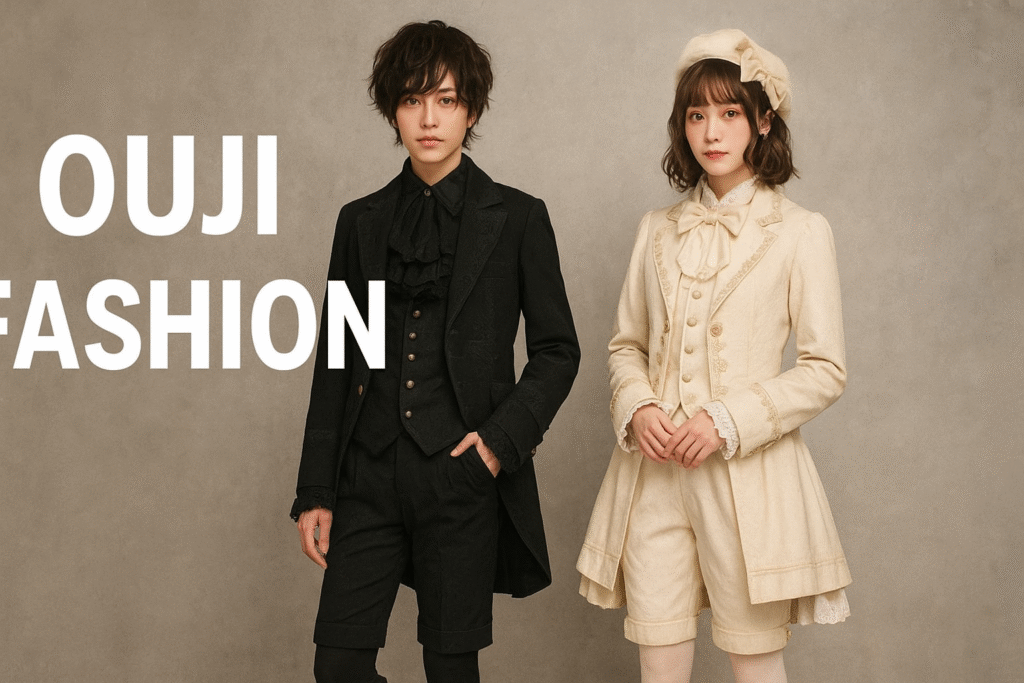In the world of Japanese street fashion, Ouji fashion—also known as Prince fashion—stands out as a timeless and elegant style that combines historical inspiration with modern creativity. Unlike typical men’s or women’s fashion, Ouji embraces androgyny, grace, and theatrical flair. It merges Victorian aesthetics with a princely charm, creating a look that’s bold, refined, and delightfully unique.
Many people first encounter Ouji fashion through its association with Lolita fashion, but it has its own distinct culture, community, and evolution. Whether worn by men or women, Ouji fashion is a celebration of individuality and the art of dressing like a modern-day prince.
What Is Ouji Fashion?
Ouji fashion (often written as Ōji fashion, meaning “Prince” in Japanese) is a substyle of Japanese Lolita fashion. It draws heavy inspiration from European aristocratic and Victorian boys’ clothing of the 18th and 19th centuries. The core elements include short trousers (often called breeches or bloomers), tailored jackets, ruffled shirts, cravats, knee-high socks, and elegant shoes such as oxfords or heeled boots.
Unlike Lolita fashion, which is typically associated with feminine dresses and petticoats, Ouji fashion represents a more masculine—or princely—alternative. However, both styles share an emphasis on elaborate details, fine fabrics, and historical influences.
In short, Ouji fashion embodies the essence of a storybook prince, blending confidence, charm, and elegance in a way that defies conventional gender norms.
Origins and Evolution of Ouji Fashion’s
Ouji fashion’s emerged in Japan during the late 1990s and early 2000s alongside Lolita fashion. While brands like Baby, the Stars Shine Bright and Moi-même-Moitié popularized the Lolita aesthetic, they also introduced Ouji pieces for those who wanted a princely counterpart to the Lolita look.
As the fashion evolved, Ouji developed its own identity. Early Ouji outfits leaned heavily on classical Victorian and Rococo influences, featuring lace, ruffles, and ornate jackets. Over time, substyles like Gothic Ouji fashion’s and Sweet Ouji fashion’s emerged, each with its own aesthetic tone—from dark elegance to pastel royalty.
Key Elements of Ouji Fashion’s
- Tailored Jackets and Vests – The foundation of every Ouji outfit. These often feature buttons, embroidery, or velvet textures.
- Short Trousers or Bloomers – Cut above the knee and sometimes accompanied by lace or ribbons.
- Ruffled Shirts – White or cream shirts with jabots, bows, or high collars.
- Knee-High Socks or Stockings – Often paired with garters or patterned designs.
- Elegant Footwear – Heeled boots, loafers, or vintage-inspired shoes.
- Accessories – Hats, gloves, canes, pocket watches, and chokers add character and depth.
- Makeup and Hair – Both male and female Ouji wearers experiment with soft makeup, curls, or short, styled haircuts to complete the look.
Ouji Fashion’s Male: The Classic Prince Look
When people think of Ouji fashion’s for men, they imagine a look that blends refinement with rebellion. Male wearers of Ouji fashion’s typically opt for structured silhouettes and darker color palettes—think black velvet, navy, or burgundy.
Men in Ouji fashion often draw inspiration from Gothic aristocrats and European royalty. They combine ruffled shirts with tailored coats, lace gloves, and knee-high boots to achieve a dramatic yet noble appearance. Unlike standard menswear, Ouji allows creativity and fluidity—adding lace, ribbons, or makeup without fear of judgment.
It’s not just clothing; it’s a declaration of freedom in fashion—where masculinity meets grace.
Ouji Fashion’s Female: The Androgynous Royalty
Ouji fashion’s for women embraces androgyny while maintaining elegance. Many women who love Lolita fashion also explore Ouji to express a different side of their personality—one that’s more princely than princess-like.
Female Ouji wearers often style their outfits with fitted shorts, lace cravats, and jackets that balance femininity with strength. The appeal lies in breaking boundaries—proving that fashion can be powerful and poetic at the same time.
This style celebrates individuality, letting women channel the spirit of a storybook prince with confidence and flair.
Gothic Ouji Fashion’s
One of the most recognizable substyles is Gothic Ouji fashion’s. It draws from dark romanticism and Victorian mourning attire. Black, charcoal, and deep jewel tones dominate this aesthetic, while details like crosses, lace, and velvet emphasize a sense of mystery and nobility.
Gothic Ouji fashion’s often overlaps with Aristocrat fashion, another subculture focused on dark elegance and old-world refinement. The gothic look appeals to those who enjoy drama, history, and a timeless, melancholic beauty.
Sweet Ouji Fashion’s
Sweet Ouji fashion’s stands on the opposite end of the spectrum. Instead of dark tones, it embraces pastels, creams, and whites, often accented with playful prints, bows, and soft fabrics.
Sweet Ouji captures the innocence of childhood with a princely twist. It’s charming, lighthearted, and whimsical—perfect for those who want to add a softer personality to the structured silhouette of Ouji fashion.
Victorian Ouji Fashion’s
Victorian Ouji fashion takes direct inspiration from the 19th-century British and French aristocracy. It focuses on rich materials like brocade, silk, and velvet. This style highlights long-tailed coats, lace cuffs, and waistcoats that mirror Victorian gentlemen’s fashion—but with a modern, theatrical spin.
For many enthusiasts, this style represents the purest form of Ouji fashion—luxurious, historical, and regal.
Casual Ouji Fashion’s
While traditional Ouji outfits can look elaborate, casual Ouji fashion’s brings the style into everyday life. It simplifies the layers and accessories, focusing on comfort without losing the aesthetic.
For example, you might see someone wearing a short jacket, fitted shorts, patterned socks, and loafers without the heavy lace or ruffles. Casual Ouji allows wearers to express their love for the style in daily settings—like meetups, outings, or fashion conventions.
Prince Ouji Fashion’s
The term Prince Ouji fashion literally defines the essence of the style: dressing like a prince. It’s about embodying confidence, grace, and charisma. The look may include a royal-themed jacket, ornamental brooches, and a noble color palette.
Prince Ouji fashion symbolizes leadership, poise, and the fantasy of stepping into an aristocratic fairy tale.
Aristocrat Ouji Fashion
Closely related to Gothic styles, Aristocrat Ouji fashion leans toward sophistication and maturity. It uses darker, muted tones and focuses on fine tailoring. The emphasis is less on cuteness and more on refined, commanding presence.
This substyle is often popular among older fans of Ouji and Lolita fashion who appreciate historical European influences with an elegant, mysterious edge.
Plus Size Ouji Fashion
Fashion inclusivity has expanded, and plus-size Ouji fashion now provides beautiful options for people of all body types. Many independent brands and custom tailors create bespoke pieces that maintain the style’s integrity while offering comfortable, flattering fits.
The Ouji community celebrates diversity—showing that style, not size, defines elegance.
Lolita and Ouji Fashion: The Twin Styles
While Lolita fashion focuses on the feminine, doll-like aesthetic, Ouji fashion’s presents the masculine, princely counterpart. They often appear together at events, fashion shows, or meetups, creating a beautiful visual harmony—princess and prince.
Both styles share key values: attention to detail, high-quality craftsmanship, and a love for fantasy-inspired fashion rooted in elegance and individuality.
Ouji Fashion’s Dress and Outfits
Though Ouji typically revolves around shorts or trousers, Ouji fashion’s dresses do exist—especially in Sweet or Aristocrat variations. These outfits often blend elements of Lolita and Ouji styles, creating a hybrid look that’s playful yet structured.
Accessories like capes, waistcoats, chokers, and gloves complete the ensemble, allowing every wearer to create a personal version of their royal alter ego.
Ouji Fashion’s Brands
Some of the most beloved Ouji fashion’s brands include:
- Atelier Boz – Known for structured gothic pieces and luxurious tailoring.
- Alice and the Pirates – Offers a balance between dark and romantic Ouji looks.
- Moi-même-Moitié – Founded by Mana, this brand defines Gothic elegance.
- Triple Fortune – Specializes in ornate hats and accessories perfect for Ouji styling.
- Atelier Pierrot – Combines historical influences with dramatic silhouettes.
These brands helped define the global recognition of Ouji fashion and continue to inspire designers and enthusiasts worldwide.
Where to Buy Ouji Fashion’s
If you’re wondering where to buy Ouji fashion, you can explore:
- Official brand stores like Alice and the Pirates or Atelier Boz.
- Japanese fashion retailers that specialize in street and subculture wear.
- Online marketplaces such as secondhand fashion sites and independent designers who sell handmade Ouji pieces.
For those new to the style, it’s wise to start with versatile basics—a tailored jacket, a pair of prince shorts, and a ruffled shirt—then expand your wardrobe with accessories and custom pieces.
Why People Love Ouji Fashion’s
People love Ouji fashion because it celebrates individuality, creativity, and elegance without conforming to traditional gender roles. It allows wearers to express themselves in a regal, artistic, and fearless way.
It’s not just clothing—it’s a lifestyle and a form of self-expression that connects people who value art, history, and personal freedom.
Read More: https://acubi.us/custom-screen-printed-t-shirts/
Conclusion
Ouji fashion stands as one of the most intriguing and expressive forms of Japanese street style. With its roots in Victorian elegance and its branches stretching into modern creativity, it continues to evolve while keeping its princely charm alive.
Whether you love Gothic Ouji fashion, Sweet Ouji fashion’s, or Casual Ouji fashion’s, the essence remains the same: the courage to dress like royalty in your own unique way. For both men and women, Ouji fashion‘s represents confidence, grace, and timeless beauty—a true tribute to the art of self-expression.



